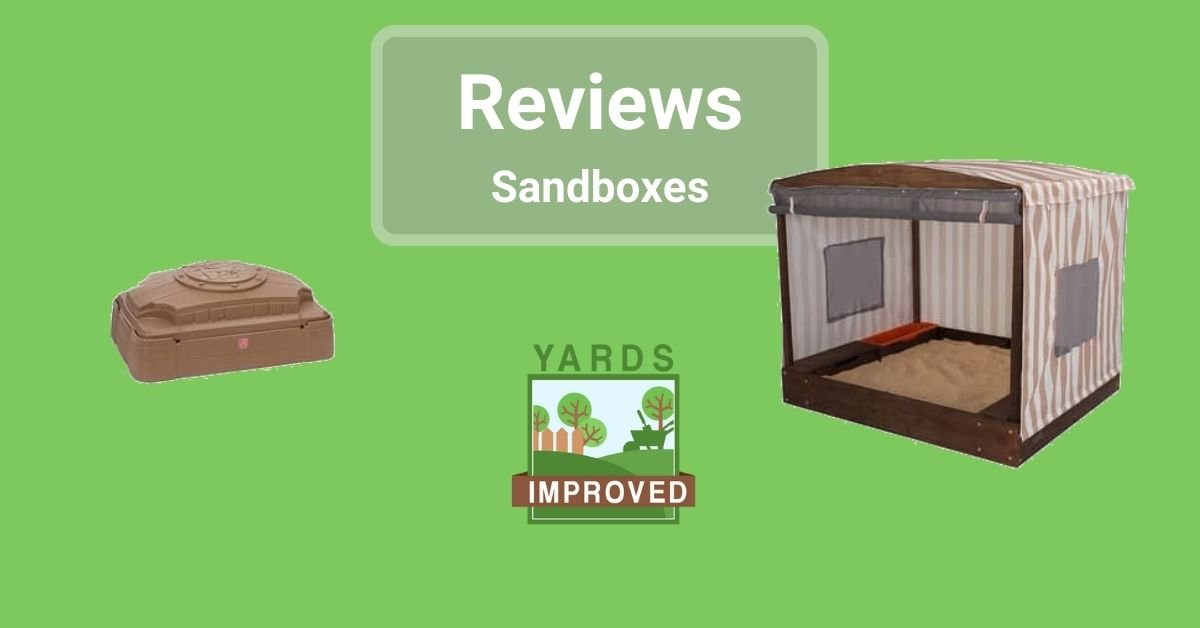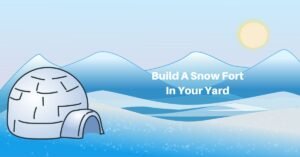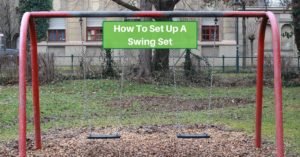Ready to provide your kids with a sandbox to help them enjoy some great time in the backyard? They’ll love having their own space to play as they build, bury toys, and much more. So how do you choose the ideal sandbox that your kids will love – and that won’t make life more difficult for yourself?
Options For Adding A Sandbox To Your Yard
There are a few ways to add a sandbox.
You could build it yourself. It’s not a complicated project – choose an appropriate wood and assemble it. The corners can be square, so there are no odd cuts needed.
Of course, if you don’t want to do it yourself, you could hire a carpenter to do it for you.
And if you’d rather skip either of those options, you can buy a sandbox. There are many great ones available in both wood and plastic. The wooden ones may require some assembly, but the parts are all included and pre-drilled. The plastic ones are often smaller, but you can simply place them in the yard and fill them.
Below, we’re going to review some of those pre-made sandboxes to help you choose!
There are lots of great sandbox toys, like the building blocks you’ll find here!
What To Consider
A sandbox is simply a large container to hold sand. You can’t get much simpler than that. However, there are still some factors to take into consideration.
Size
If you build your sandbox, you can make it as big as you’d like. But if you buy one, you still have a decent range of options.
Of course, if you have more than one child (or they frequently have playmates over), you’ll want something a little larger. Also, consider how your child will grow. Sandboxes are popular with toddlers through preschoolers, so the smallest ones might seem too confining when the child reaches 3 or 4 years of age.
Safety
Of course, safety is always a concern, especially with children. When it comes to sandboxes, you want to double-check that all nuts, bolts, and nails are properly attached. Screws are preferable to nails. Also, look out for splintering.
Plastic can sometimes have sharp edges. This is usually around the edge stuck in the ground. It’s still best to sand rough places to keep your child safe.
Ease of Cleaning
A clean sandbox not only looks better, but it’s safer and more fun! Sandbox cleaning isn’t complicated but sometimes the design can make it tougher than it needs to be. A simple design without too many spots for sand or germs to get stuck makes a big difference.
Cover
Part of keeping your sandbox clean and free of debris is a good cover. If you buy a sandbox, consider one that includes a cover. It can be a hard cover made of the same material as the box. Or it can be a soft canvas or tarpaulin cover.
If it doesn’t include a cover, be sure to get something else that will serve the purpose.
Portability
Some sandboxes – especially wooden ones – are heavy. They may even be staked to the ground to improve their stability.
However, plastic ones are often lighter and smaller. You probably want to bring them inside over the winter. You might even move them if you’re expecting heavy winds and rains. But you want to be sure that they’re easy enough for you to move them, too. Think about the size and weight – as well as where you can store it out of harm’s way.
Reviews of the Best Premade Sandboxes
We checked out some great options among wood and plastic sandboxes and want to share what we’ve found out! Read before you buy to get a better idea of which will suit your needs.
KidKraft Wooden and Canvas Outdoor Cabana Sandbox
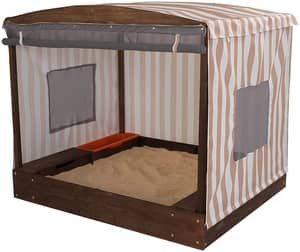

This unique idea for a sandbox offers something rarely seen: it’s inside a “tent.” The cabana-style play area gives kids the advantage of being protected from the sun while enjoying the sand.
The sides are canvas with windows on each end. The windows are a see-through mesh. They were a relief to us; we wouldn’t recommend this toy if it blocked our view from various sides! The sides can roll up, too, when you want a more open experience.
The overall measures are 48.3 inches by 57 inches. At the center of the roof, it’s 50.9 inches. The sand bed itself is about 5 inches deep. Overall, the box holds about 660 pounds of sand. The bottom is a plastic liner.
There are benches on either end of the play area. You can lift the benches to access a small storage area underneath.
The wood frame is solid and weather-resistant. The canvas mesh is also durable.
The cover will protect against moderate rain, but you should still get a tarp to cover the sand from insects, animals, and more intense weather.
Some people report that the grommets on the cover rust quickly and that the cover doesn’t last more than a season. However, that seems to happen rarely.
Overall, we think this is a fantastic idea for a sandbox and will bring lots of enjoyment protected even from the sun!
Creative Cedar Designs Octagon Wooden Cedar Sandbox with Seat Boards
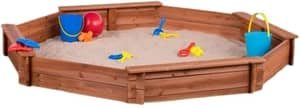

Your youngster can step into the octagon – and no, we’re not talking about the UFC fights! We love the design of this sandbox. The wood is cedar so it should deter bugs, too.
It measures 84 inches by 79 inches and is 9 inches deep. Four of the eight sides have benches for your kids to sit on as they play.
To fill this sandbox, it will take about 800-1000 pounds of sand to provide a comfortable depth.
The bottom is a textile that allows water to pass through but keeps the sand in the box. It’s durable; you won’t have to worry about it tearing.
It’s also easy to assemble – the wood panels slide together almost like Lincoln logs. They snap into place quickly and without the need for tools.
A fitted cover keeps out debris and insects. When it rains, though, it might sag from the weight of the water. You could strategically position a few buckets underneath, though, so that water will flow off.
Covered Convertible Cedar Sandbox with Two Bench Seats
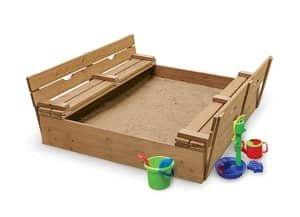

We didn’t get the “convertible” in the name of this sandbox until we looked twice – but we like this neat idea! It has a built-in cover that unfolds to form benches on either side. It’s a cool – and useful – idea.
Other than that, this is a quality sandbox with minimal frills. The cedar wood repels insects. It’s sturdy. It’s on the small side but great for one or two youngsters.
The box is 46.5 inches square and 9 inches deep. It holds around 750 pounds of sand.
There is no bottom included with this sandbox. You could place it directly on your lawn, but the sand could do long-term damage to the soil. You might consider a tarp underneath it.
You also might want a tarp to cover it. The built-in lid is fine for keeping out cats, but it won’t keep the sand safe from insects or rain.
Assembly is not difficult, but it does require attaching 12 hinges. You might want to consider better hinges; they are probably the weakest feature of this box.
Again, it’s nothing fancy but it does the job. It’ll be enjoyable for your children. We suggest not letting youngsters “help” with folding and unfolding the lid, as we imagine they could pinch their fingers. But overall, it’s a worthwhile investment.
Little Tikes Big Digger Sandbox
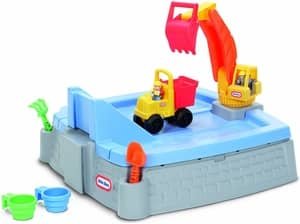

This small plastic sandbox includes a great bonus: it includes a crane mounted onto the side and other construction-related toys!
Little Tikes is a leading toy company, and they don’t disappoint here. The sandbox is 61.74 inches by 47 inches, and 13 inches high. It’s made of molded plastic; the sides look like bricks.
The lid flips over and serves as a ramp for the included truck. The package also includes a shovel, a rake, a sand sifter, a sand cup, and two worker figures.
Normally, children would play while sitting outside, not in, this sandbox. They can sit or kneel at the side.
It holds from 100 to 150 pounds of sand.
It’s sturdy – like all Little Tikes toys. It’s appropriate for children 3 – 5 years old.
The cover can be a little tough to manipulate, but it protects against insects, larger critters, and the weather.
Step2 Play and Store Sandbox With Cover
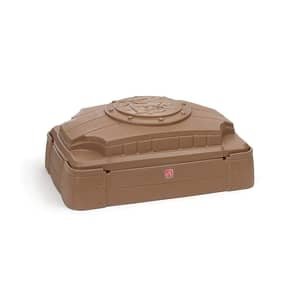

This is another small plastic sandbox that may allow one or perhaps two children to play at a time. There are even small seats in each corner.
At 28 inches by 42 inches and 11 inches deep, it’s a good bit smaller than any of the other sandboxes we’ve reviewed. But that doesn’t take away any of the fun your child can have in it. That also makes it quicker to clean and easier to pick up and store.
It can hold about 200 pounds of sand.
The included lid will protect it from critters and the rain. However, a clever animal may be able to slide it off. High winds could also lift it off, so you may want to fasten it down with bungee cords.
It’s a durable sandbox that lends itself to long-lasting use.
Conclusion
Your children will love their new sandbox! Be sure to get one that’s easy to care for, safe, and a good size for them and their friends to enjoy. There are great pre-made options available in both wood and plastic if you don’t want to build it yourself!

